Long-Lasting Silver Nanoparticles Synthesized with Tagetes erecta and Their Antibacterial Activity against Erwinia amylovora, a Serious Rosaceous Pathogen
Abstract
1. Introduction
2. Results
2.1. AgNP Synthesis and UV-Vis Spectrophotometry
2.2. The Size and Sphericity of the AgNPs
2.3. Annular Dark Field (HAADF) in STEM Mode and EDS Elemental Microanalysis
2.4. Selected Area Electron Diffraction Pattern and High-Resolution TEM
2.5. FTIR Spectral Analysis
2.6. Qualitative Identification of Secondary Metabolites
2.7. Antibacterial Activity of the Synthesized AgNPs
3. Discussion
4. Materials and Methods
4.1. Plant Material
4.2. Silver Nanoparticle Synthesis
4.3. UV-Vis Surface Plasmon Resonance (SPR)
4.4. The Morphology, Size, and Structure of the AgNPs
4.5. High-Angle Annular Dark-Field Scanning Transmission Electron Microscopy (HAADF-STEM) and Energy-Dispersive X-ray Spectroscopy (EDS)
4.6. Fourier Transform Infrared Spectroscopy (FTIR)
4.7. Preliminary Test for the Secondary Metabolites
4.8. Thin-Layer Chromatography
4.9. Antibacterial Activity of the Silver Nanoparticles
5. Conclusions
Author Contributions
Funding
Data Availability Statement
Acknowledgments
Conflicts of Interest
References
- Mohammadinejad, R.; Karimi, S.; Iravani, S.; Varma, R.S. Plant-derived nanostructures: Types and applications. Green Chem. 2016, 18, 20–52. [Google Scholar] [CrossRef]
- Mohamad, N.A.N.; Arham, N.A.; Jai, J.; Hadi, A. Plant extract as reducing agent in synthesis of metallic nanoparticles: A Review. Adv. Mat. Res. 2013, 832, 350–355. [Google Scholar] [CrossRef]
- Kumar, V.; Singh, D.K.; Mohan, S.; Hasan, S.H. Photo-induced biosynthesis of silver nanoparticles using aqueous extract of Erigeron bonariensis and its catalytic activity against acridine orange. J. Photochem. Photobiol. B Biol. 2016, 155, 39–50. [Google Scholar] [CrossRef] [PubMed]
- Tarannum, N.; Divya, D.; Gautam, Y.K. Facile green synthesis and applications of silver nanoparticles: A state-of-the-art review. RSC Adv. 2019, 9, 34926–34948. [Google Scholar] [CrossRef] [PubMed]
- Gajendran, B.; Durai, P.; Varier, K.M.; Liu, W.; Li, Y.; Rajendran, S.; Chinnasamy, A. Green synthesis of silver nanoparticle from Datura inoxia flower extract and its cytotoxic activity. BioNanoScience 2019, 9, 564–572. [Google Scholar] [CrossRef]
- Gogoi, N.; Babu, P.J.; Mahanta, C.; Bora, U. Green synthesis and characterization of silver nanoparticles using alcoholic flower extract of Nyctanthes arbortristis and in vitro investigation of their antibacterial and cytotoxic activities. Mater. Sci. Eng. C 2015, 46, 463–469. [Google Scholar] [CrossRef] [PubMed]
- Padalia, H.; Moteriya, P.; Chanda, S. Green synthesis of silver nanoparticles from marigold flower and its synergistic antimicrobial potential. Arab. J. Chem. 2015, 8, 732–741. [Google Scholar] [CrossRef]
- Moteriya, P.; Chanda, S. Biosynthesis of silver nanoparticles formation from Caesalpinia pulcherrima stem metabolites and their broad spectrum biological activities. J. Genet. Eng. Biotechnol. 2018, 16, 105–113. [Google Scholar] [CrossRef]
- Islam, N.U.; Amin, R.; Shahid, M.; Amin, M. Gummy gold and silver nanoparticles of apricot (Prunus armeniaca) confer high stability and biological activity. Arab. J. Chem. 2019, 12, 3977–3992. [Google Scholar] [CrossRef]
- Ontong, J.C.; Paosen, S.; Shankar, S.; Voravuthikunchai, S.P. Eco-friendly synthesis of silver nanoparticles using Senna alata bark extract and its antimicrobial mechanism through enhancement of bacterial membrane degradation. J. Microbiol. Methods 2019, 165, 105–692. [Google Scholar] [CrossRef]
- Kgatshe, M.; Aremu, O.S.; Katata-Seru, L.; Gopane, R. Characterization and antibacterial activity of biosynthesized silver nanoparticles using the ethanolic extract of Pelargonium sidoides DC. J. Nanomater. 2019, 2019, 3501234. [Google Scholar] [CrossRef]
- Doan, V.D.; Huynh, B.A.; Nguyen, T.D.; Cao, X.T.; Nguyen, V.C.; Nguyen, T.L.H.; Le, V.T. Biosynthesis of silver and gold nanoparticles using aqueous extract of Codonopsis pilosula roots for antibacterial and catalytic applications. J. Nanomater. 2020, 2020, 8492016. [Google Scholar] [CrossRef]
- Nayak, S.; Sajankila, S.P.; Rao, C.V.; Hegde, A.R.; Mutalik, S. Biogenic synthesis of silver nanoparticles using Jatropha curcas seed cake extract and characterization: Evaluation of its antibacterial activity. Energy Source Part A Recovery Util. Environ. Eff. 2019, 24, 3415–3423. [Google Scholar] [CrossRef]
- Tso, C.; Zhung, C.; Shih, Y.; Tseng, Y.M.; Wu, S.; Doong, R. Stability of metal oxide nanoparticles in aqueous solutions. Water Sci. Technol. 2010, 61, 127–133. [Google Scholar] [CrossRef]
- Oćwieja, M.; Adamczyk, Z.; Morga, M.; Kubiak, K. Silver particle monolayers—Formation, stability, applications. Adv. Colloid Interface Sci. 2015, 222, 530–563. [Google Scholar] [CrossRef] [PubMed]
- Keerthana, S.H.; Fathima, R.; Radhakrishnan, P.; Mujeeb, A. Evaluation of stability of laser ablated colloidal silver nanoparticles using dynamic laser speckle technique. Optik 2021, 244, 167573. [Google Scholar] [CrossRef]
- Jiang, M.; Xu, Y.; Wang, L.; Liu, J.; Yu, J.; Chen, H. High level of intraspecific divergence and low frequency of RNA editing in the chloroplast genome sequence of Tagetes erecta. Mitochondrial DNA Part B 2020, 5, 2948–2953. [Google Scholar] [CrossRef]
- Ayub, M.A.; Hussain, A.I.; Hanif, M.A.; Chatha, S.A.S.; Kamal, G.M.; Shahid, M.; Janneh, O. Variation in phenolic profile, β-carotene and flavonoid contents, biological activities of two Tagetes species from pakistani flora. Chem. Biodivers. 2017, 14, e1600463. [Google Scholar] [CrossRef]
- Salehi, B.; Valussi, M.; Morais-Braga, M.; Carneiro, J.; Leal, A.; Coutinho, H.; Sharifi-Rad, J. Tagetes spp. essential oils and other extracts: Chemical characterization and biological activity. Molecules 2018, 23, 2847. [Google Scholar] [CrossRef]
- Vasudevan, P.; Kashyap, S.; Sharma, S. Tagetes: A multipurpose plant. Bioresour. Technol. 1997, 62, 29–35. [Google Scholar] [CrossRef]
- Abbasifar, A.; Ghani, S.; Irvani, M.A.; Rafiee, B.; Kaji, B.V.; Akbari, A. Antibacterial activity of silver nanoparticles synthesized by using extracts of Hedera helix. Zahedan J. Res. Med. Sci. 2017, 19, e5920. [Google Scholar] [CrossRef]
- Allafchian, A.R.; Mirahmadi-Zare, S.Z.; Jalali, S.A.H.; Hashemi, S.S.; Vahabi, M.R. Green synthesis of silver nanoparticles using phlomis leaf extract and investigation of their antibacterial activity. J. Nanostruct. Chem. 2016, 6, 129–135. [Google Scholar] [CrossRef]
- Parmagnani, A.S.; Kanchiswamy, C.N.; Paponov, I.A.; Bossi, S.; Malnoy, M.; Maffei, M.E. Bacterial Volatiles (mVOC) Emitted by the Phytopathogen Erwinia amylovora Promote Arabidopsis thaliana growth and oxidative stress. Antioxidants 2023, 12, 600. [Google Scholar] [CrossRef]
- Hassan, W.; Ahmed, O.; Hassan, R.E.; Youssef, S.A.; Shalaby, A.A. Isolation and characterization of three bacteriophages infecting Erwinia amylovora and their potential as biological control agent. Egypt. J. Biol. Pest Control 2023, 33, 60. [Google Scholar] [CrossRef]
- Van der Zwet, T.; Orolaza-Halbrendt, N.; Zeller, W. Losses due to fire blight and economic importance of the disease. In Fire Blight: History, Biology, and Management; APS Press: St. Paul, MN, USA, 2016; pp. 37–41. [Google Scholar] [CrossRef]
- Aktepe, B.P.; Aysan, Y. Biological control of fire blight disease caused by Erwinia amylovora on apple. Erwerbs-Obstbau 2023, 65, 645–654. [Google Scholar] [CrossRef]
- Choe, J.; Kim, B.; Park, M.K.; Roh, E. Biological and genetic characterizations of a novel lytic ΦFifi106 against indigenous Erwinia amylovora and evaluation of the control of fire blight in apple plants. Biology 2023, 12, 1060. [Google Scholar] [CrossRef] [PubMed]
- Ponce, A.; Mejía-Rosales, S.; José-Yacamán, M. Scanning transmission electron microscopy methods for the analysis of nanoparticles. In Nanoparticles in Biology and Medicine. Methods in Molecular Biology; Soloviev, M., Ed.; Humana Press: Totowa, NJ, USA, 2012; Volume 906, pp. 453–471. [Google Scholar] [CrossRef]
- Bai, H.J.; Yang, B.S.; Chai, C.J.; Yang, G.E.; Jia, W.L.; Yi, Z.B. Green synthesis of silver nanoparticles using Rhodobacter Sphaeroides. World J. Microbiol. Biotechnol. 2011, 27, 2723–2728. [Google Scholar] [CrossRef]
- Buszewski, B.; Rafilska, K.; Pomastowski, P.; Walczak, J.; Rogowska, A. Novel aspects of silver nanoparticles functionalization. Colloids Surf. A Physicochem. Eng. Aspect 2016, 506, 170–178. [Google Scholar] [CrossRef]
- Murthy, H.C.A.; Desalegn, T.; Kassa, M.; Abebe, B.; Assefa, T. Synthesis of green copper nanoparticles using medicinal plant Hagenia abyssinica (Brace) JF. Gmel. leaf extract: Antimicrobial properties. J. Nanomater. 2020, 2020, 3924081. [Google Scholar] [CrossRef]
- Mondal, S.; Roy, N.; Laskar, R.A.; Sk, I.; Basu, S.; Mandal, D.; Begum, N.A. Biogenic synthesis of Ag, Au and bimetallic Au/Ag alloy nanoparticles using aqueous extract of mahogany (Swietenia mahogani JACQ.) leaves. Colloids Surf. B Biointerfaces 2011, 82, 497–504. [Google Scholar] [CrossRef]
- Jain, S.; Mehata, M.S. Medicinal plant leaf extract and pure flavonoid mediated green synthesis of silver nanoparticles and their enhanced antibacterial property. Sci. Rep. 2017, 7, 15867. [Google Scholar] [CrossRef] [PubMed]
- Raja, S.; Ramesh, V.; Thivaharan, V. Green biosynthesis of silver nanoparticles using Calliandra haematocephala leaf extract, their antibacterial activity and hydrogen peroxide sensing capability. Arab. J. Chem. 2017, 10, 253–261. [Google Scholar] [CrossRef]
- Kukreti, S.; Kaushik, M. Exploring the potential of environment friendly silver nanoparticles for DNA interaction: Physicochemical approach. J. Photochem. Photobiol. B 2019, 194, 158–165. [Google Scholar] [CrossRef]
- Amirjani, A.; Firouzi, F.; Haghshenas, D.F. Predicting the size of silver nanoparticles from their optical properties. Plasmonics 2020, 15, 1077–1082. [Google Scholar] [CrossRef]
- Majumdar, R.; Kar, P.K. Biosynthesis, characterization and anthelmintic activity of silver nanoparticles of Clerodendrum infortunatum isolate. Sci. Rep. 2023, 13, 7415. [Google Scholar] [CrossRef] [PubMed]
- Wang, Y.; Wei, S.; Wang, K.; Wang, Z.; Duan, J.; Cui, L.; Wang, S. Evaluation of biosynthesis parameters, stability and biological activities of silver nanoparticles synthesized by Cornus officinalis extract under 365 nm UV radiation. RSC Adv. 2020, 10, 27173–27182. [Google Scholar] [CrossRef] [PubMed]
- Raveendran, P.; Fu, J.; Wallen, S.L. Completely “green” synthesis and stabilization of metal nanoparticles. J. Am. Chem. Soc. 2003, 125, 13940–13941. [Google Scholar] [CrossRef] [PubMed]
- Singh, V.; Yadav, P.; Mishra, V. Recent Advances on Classification, Properties, Synthesis, and Characterization of Nanomaterials. In Green Synthesis of Nanomaterials for Bioenergy Applications; Srivastava, N., Srivastava, M., Mishra, P.K., Gupta, V.K., Eds.; John Wiley & Sons Ltd., Wiley Online Library: Hoboken, NJ, USA, 2020; Volume 7, pp. 83–97. [Google Scholar] [CrossRef]
- Khan, M.R.; Urmi, M.A.; Kamaraj, C.; Malafaia, G.; Ragavendran, C.; Rahman, M.M. Green synthesis of silver nanoparticles with its bioactivity, toxicity and environmental applications: A comprehensive literature review. Environ. Nanotechnol. Monit. Manag. 2023, 20, 100872. [Google Scholar] [CrossRef]
- Krithiga, N.; Rajalakshmi, A.; Jayachitra, A. Green synthesis of silver nanoparticles using leaf extracts of Clitoria ternatea and Solanum nigrum and study of its antibacterial effect against Common. Nosocomial Pathogens. J. Nanosci. 2015, 2015, 928204. [Google Scholar] [CrossRef]
- Omidi, S.; Sedaghat, S.; Tahvildari, K.; Derakhshi, P.; Motiee, F. Biosynthesis of silver nanocomposite with Tarragon leaf extract and assessment of antibacterial activity. J. Nanostruct. Chem. 2018, 8, 171–178. [Google Scholar] [CrossRef]
- Sivaramakrishnan, M.; Jagadeesan-Sharavanan, V.; Karaiyagowder-Govindarajan, D.; Meganathan, Y.; Devaraj, B.S.; Natesan, S.; Kandaswamy, K. Green synthesized silver nanoparticles using aqueous leaf extracts of Leucas aspera exhibits antimicrobial and catalytic dye degradation properties. SN Appl. Sci. 2019, 1, 208. [Google Scholar] [CrossRef]
- Wei, S.; Wang, Y.; Tang, Z.; Xu, H.; Wang, Z.; Yang, T.; Zou, T. A novel green synthesis of silver nanoparticles by the residues of Chinese herbal medicine and their biological activities. RSC Adv. 2021, 11, 1411–1419. [Google Scholar] [CrossRef]
- Dykman, L.A.; Bogatyrev, V.A. Gold nanoparticles: Preparation, functionalisation and applications in biochemistry and immunochemistry. Russ. Chem. Rev. 2007, 76, 181–194. [Google Scholar] [CrossRef]
- Moradi, F.; Sedaghat, S.; Moradi, O.; Arab Salmanabadi, S. Review on green nano-biosynthesis of silver nanoparticles and their biological activities: With an emphasis on medicinal plants. Inorg. Nano-Met. Chem. 2020, 51, 133–142. [Google Scholar] [CrossRef]
- Devika, R.; Koilpillai, J. Phytochemical screening studies of bioactive compounds of Tagetes erecta. Int. J. Pharma Biol. Sci. 2012, 3, 596–602. [Google Scholar]
- Huang, J.; Li, Q.; Sun, D.; Lu, Y.; Su, Y.; Yang, X.; Chen, C. Biosynthesis of silver and gold nanoparticles by novel sundried Cinnamomum camphora leaf. Nanotechnology 2007, 18, 105104. [Google Scholar] [CrossRef]
- Kulkarni, N.; Muddapur, U. Biosynthesis of Metal Nanoparticles: A Review. J. Nanotechnol. 2014, 2014, 510246. [Google Scholar] [CrossRef]
- Nazar, N.; Bibi, I.; Kamal, S.; Iqbal, M.; Nouren, S.; Jilani, K.; Ata, S. Cu nanoparticles synthesis using biological molecule of P. granatum seeds extract as reducing and capping agent: Growth mechanism and photo-catalytic activity. Int. J. Biol. Macromol. 2018, 106, 1203–1210. [Google Scholar] [CrossRef]
- Maji, A.; Beg, M.; Das, S.; Aktara, M.N.; Nayim, S.; Patra, A.; Hossain, M. Study on the antibacterial activity and interaction with human serum albumin of Tagetes erecta inspired biogenic silver nanoparticles. Process Biochem. 2020, 97, 191–200. [Google Scholar] [CrossRef]
- Burlec, A.F.; Hăncianu, M.; Macovei, I.; Mircea, C.; Fifere, A.; Turin-Moleavin, I.A.; Corciovă, A. Eco-friendly synthesis and comparative in vitro biological evaluation of silver nanoparticles using Tagetes erecta flower extracts. Appl. Sci. 2022, 12, 887. [Google Scholar] [CrossRef]
- Aravind, M.; Ahmad, A.; Ahmad, I.; Amalanathan, M.; Naseem, K.; Mary, S.M.M.; Zuber, M. Critical green routing synthesis of silver NPs using jasmine flower extract for biological activities and photocatalytical degradation of methylene blue. J. Environ. Chem. Eng. 2021, 9, 104877. [Google Scholar] [CrossRef]
- Moraes, L.; Figueiredo, R.C.; Ribeiro-Andrade, R.; Pontes-Silva, A.V.; Arantes, M.L.; Giani, A.; Figueredo, C.C. High diversity of microalgae as a tool for the synthesis of different silver nanoparticles: A species-specific green synthesis. Colloid. Interface Sci. Commun. 2021, 42, 100420. [Google Scholar] [CrossRef]
- Palithya, S.; Gaddam, S.A.; Kotakadi, V.S.; Penchalaneni, J.; Challagundla, V.N. Biosynthesis of silver nanoparticles using leaf extract of Decaschistia crotonifolia and its antibacterial, antioxidant, and catalytic applications. Green Chem. Lett. Rev. 2021, 14, 137–152. [Google Scholar] [CrossRef]
- Oni, B.A.; Sanni, S.E.; Agu, K.C.; Tomomewo, O.S. Green synthesis of Ag nanoparticles from Argemone mexicana L. leaf extract coated with MOF-5 for the removal of metronidazole antibiotics from aqueous solution. J. Environ. Manag. 2023, 34, 118161. [Google Scholar] [CrossRef] [PubMed]
- Varympopi, A.; Dimopoulou, A.; Theologidis, I.; Karamanidou, T.; Kaldeli Kerou, A.; Vlachou, A.; Skandalis, N. Bactericides based on copper nanoparticles restrain growth of important plant pathogens. Pathogens 2020, 9, 1024. [Google Scholar] [CrossRef] [PubMed]
- Ait Bahadou, S.; Ouijja, A.; Karfach, A.; Tahiri, A.; Lahlali, R. New potential bacterial antagonists for the biocontrol of fire blight disease (Erwinia amylovora) in Morocco. Microb. Pathog. 2018, 117, 7–15. [Google Scholar] [CrossRef]
- Prakash, P.; Gnanaprakasam, P.; Emmanuel, R.; Arokiyaraj, S.; Saravanan, M. Green synthesis of silver nanoparticles from leaf extract of Mimusops elengi, Linn. for enhanced antibacterial activity against multi drug resistant clinical isolates. Colloids Surf. B Biointerfaces 2013, 108, 255–259. [Google Scholar] [CrossRef]
- Zhao, X.; Qiu, H.; Shao, Y.; Wang, P.; Yu, S.; Li, H.; Tan, C. Silver Nanoparticle-Modified 2D MOF nanosheets for photothermally enhanced silver ion release antibacterial treatment. Acta Phys.-Chim. Sin. 2023, 39, 221104. [Google Scholar] [CrossRef]
- Liu, H.L.; Dai, S.A.; Fu, K.Y.; Hsu, S.H. Antibacterial properties of silver nanoparticles in three different sizes and their nanocomposites with a new waterborne polyurethane. Int. J. Nanomed. 2010, 5, 1017–1028. [Google Scholar] [CrossRef]
- Hemlata; Meana, P.R.; Singh, A.P.; Tejavath, K.K. Biosynthesis of silver nanoparticles using Cucumis prophetarum aqueous leaf extract and their antibacterial and antiproliferative activity against cancer cell lines. ACS Omega 2020, 5, 5520–5528. [Google Scholar] [CrossRef]
- Xu, X.H.N.; Brownlow, W.J.; Kyriacou, S.V.; Wan, Q.; Viola, J.J. Real-time probing of membrane transport in living microbial cells using single nanoparticle optics and living cell imaging. Biochemistry 2004, 43, 10400–10413. [Google Scholar] [CrossRef]
- Origin (Pro), version number: 9.6.5.27; OriginLab Corporation: Northampton, MA, USA, 2018.
- Schneider, C.A.; Rasband, W.S.; Eliceiri, K.W. NIH Image to ImageJ: 25 years of image analysis (version number: ImageJ 1.53k/java 1.8.0_172). Nat. Methods 2012, 9, 671–675. [Google Scholar] [CrossRef]
- R Core Team. R: A Language and Environment for Statistical Computing; R Foundation for Statistical Computing: Vienna, Austria, 2023. [Google Scholar]
- Holm, S. A simple sequentially rejective multiple test procedure. Scand. J. Statist 1979, 6, 65–70. Available online: http://www.jstor.org/stable/4615733 (accessed on 5 January 2024).
- Gatan, Inc. DigitalMicrograph Software 3.5. Gatan Microscopy Suite Software. 2023. Available online: https://www.gatan.com/products/tem-analysis/digitalmicrograph-software (accessed on 20 January 2024).
- Soto-Hernández, R.M.; San Miguel-Chávez, R.; Palma-Tenango, M. Fitoquímica Experimental, D.R.; Colegio de Postgraduados: Texcoco, Mexico, 2019; ISBN 978-607-715-389-4. Available online: https://www.researchgate.net/profile/Mariana-Palma-Tenango-2/publication/337149995_Fitoquimica_Experimental/links/5dca3aa3299bf1a47b300e0e/Fitoquimica-Experimental.pdf (accessed on 20 January 2024).
- Gopinath, V.; MubarakAli, D.; Priyadarshini, S.; Priyadharsshini, N.M.; Thajuddin, N.; Velusamy, P. Biosynthesis of silver nanoparticles from Tribulus terrestris and its antimicrobial activity: A novel biological approach. Colloids Surf. B Biointerfaces 2012, 96, 69–74. [Google Scholar] [CrossRef]
- Gurunathan, S.; Han, J.W.; Kwon, D.N.; Kim, J.H. Enhanced antibacterial and anti-biofilm activities of silver nanoparticles against Gram-negative and Gram-positive bacteria. Nanoscale Res. Lett. 2014, 9, 373. [Google Scholar] [CrossRef]
- del Carmen Travieso Novelles, M.; Ortega, A.R.; Pita, B.A.; López, M.C.; Pérez, L.D.; Medina, E.A.; Pérez, O.P. Biosynthesis of fluorescent silver nanoparticles from Leea coccinea leaves and their antibacterial potentialities against Xanthomonas phaseoli pv phaseoli. Bioresour. Bioprocess. 2021, 8, 3. [Google Scholar] [CrossRef]
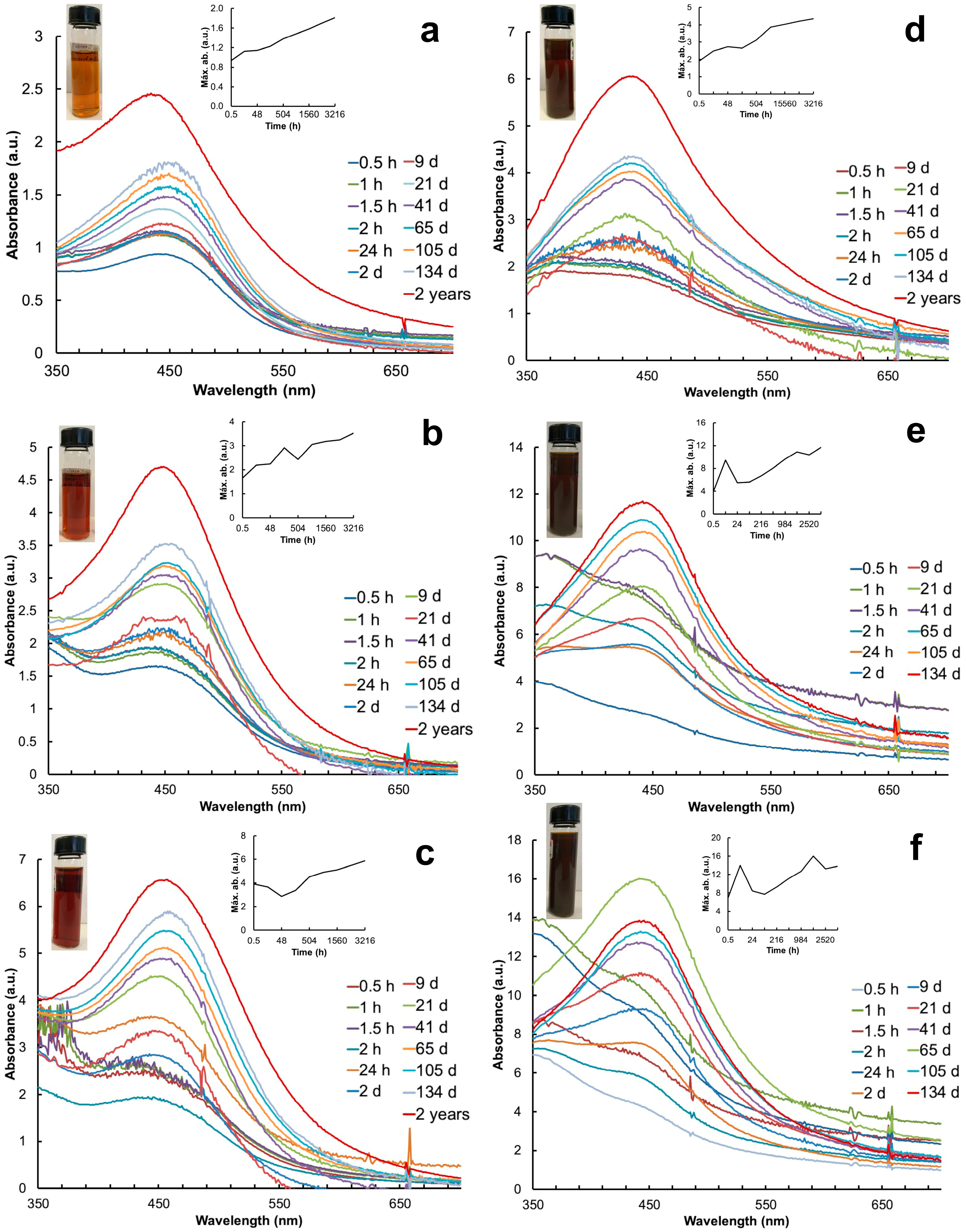
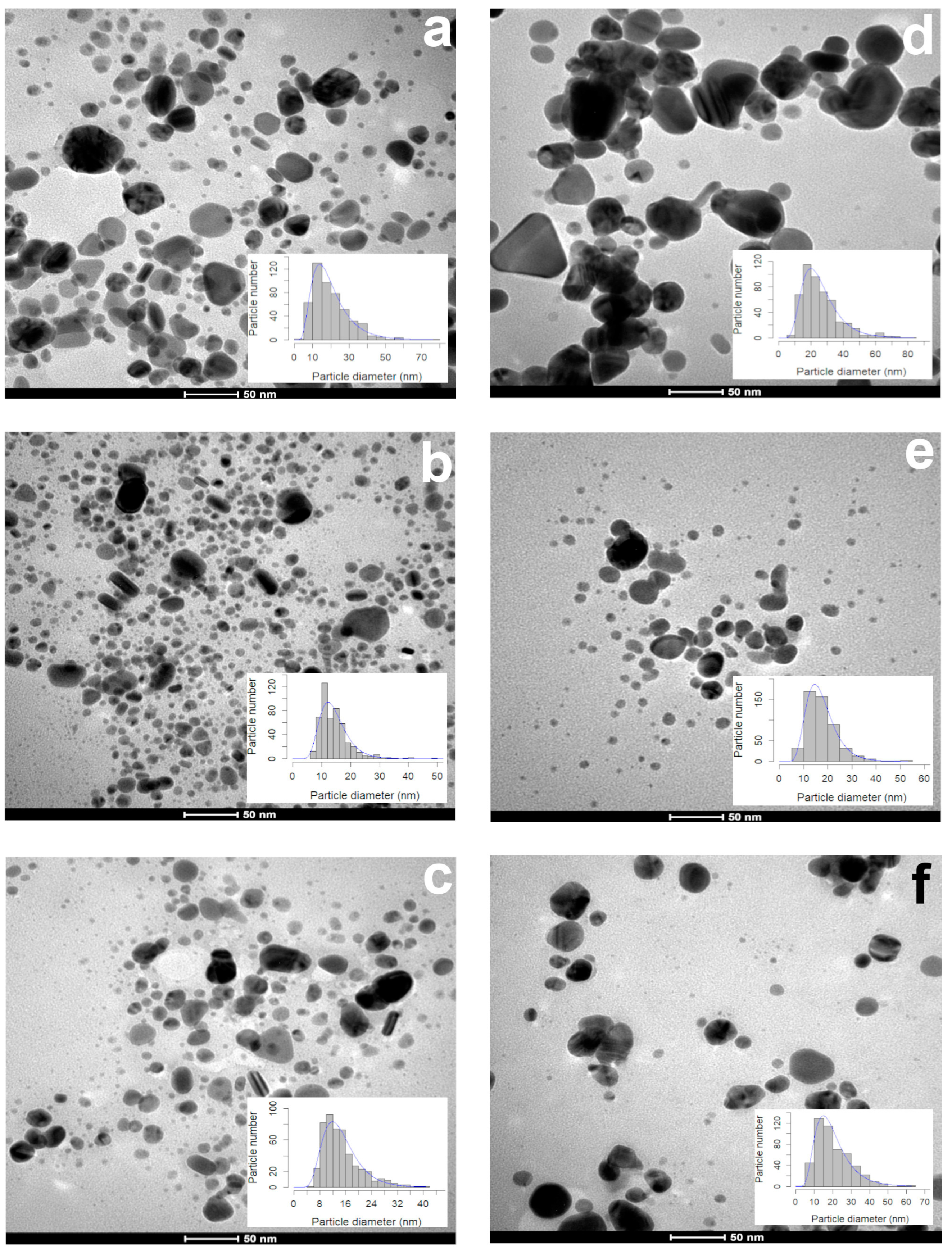
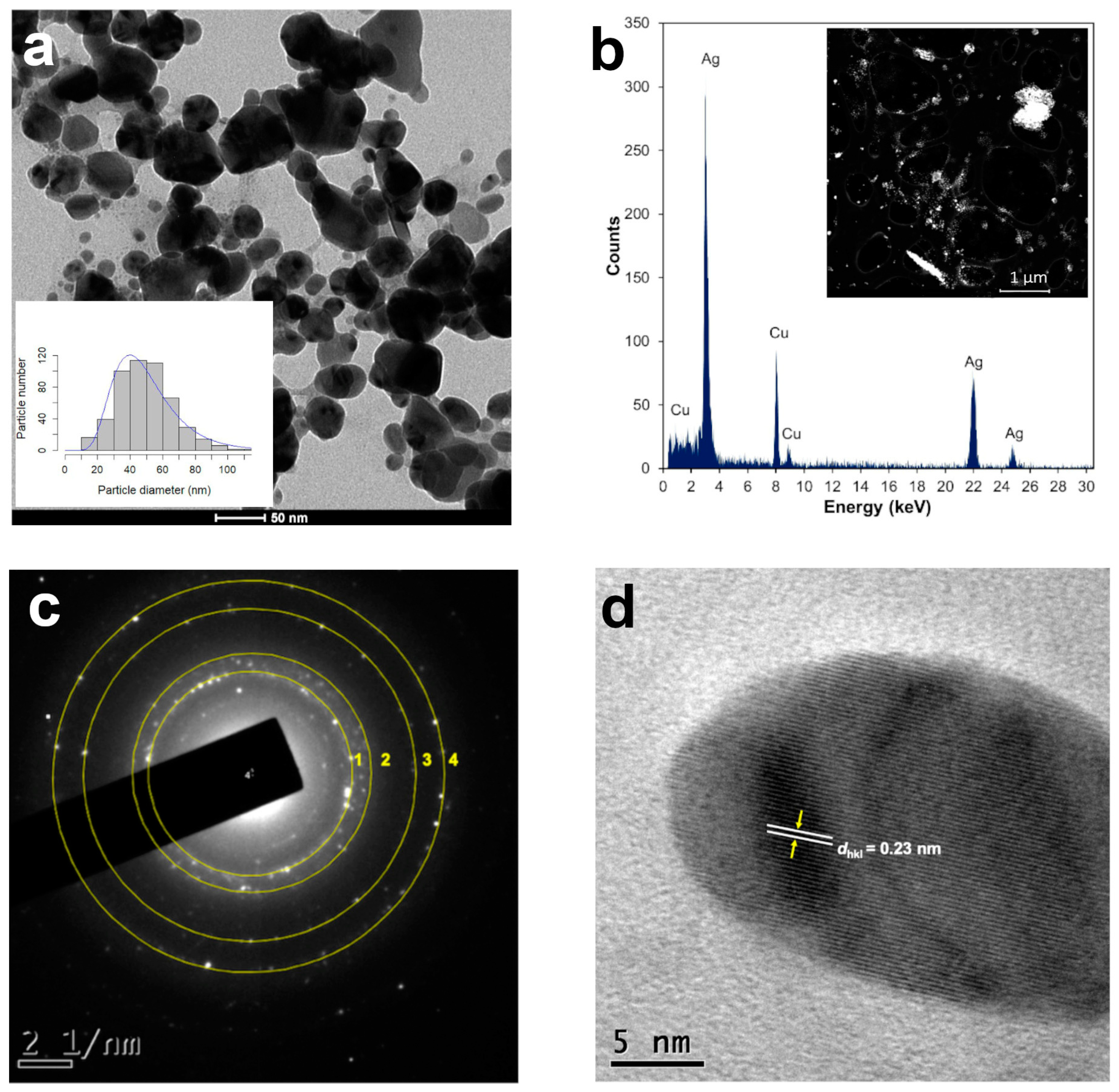
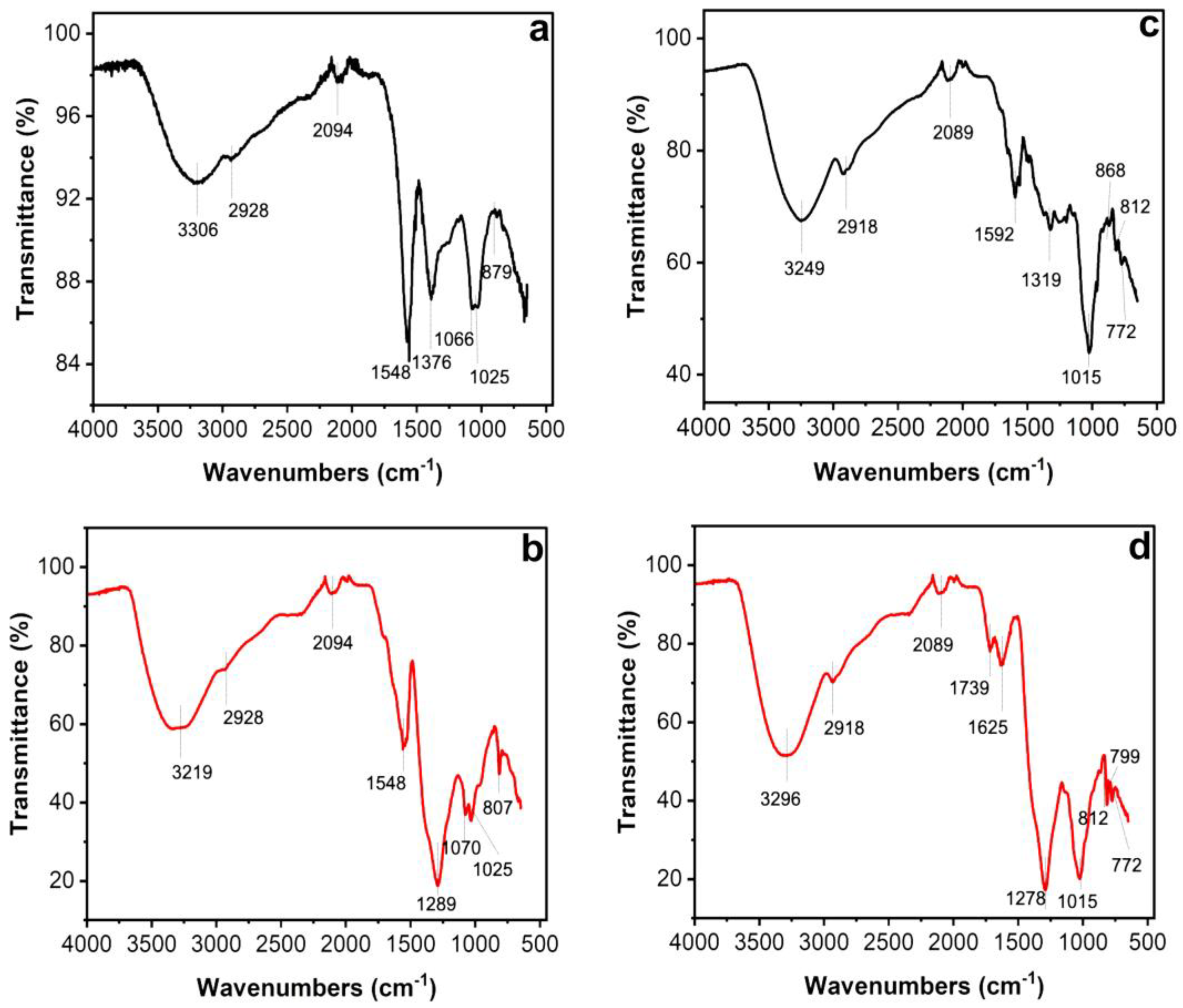
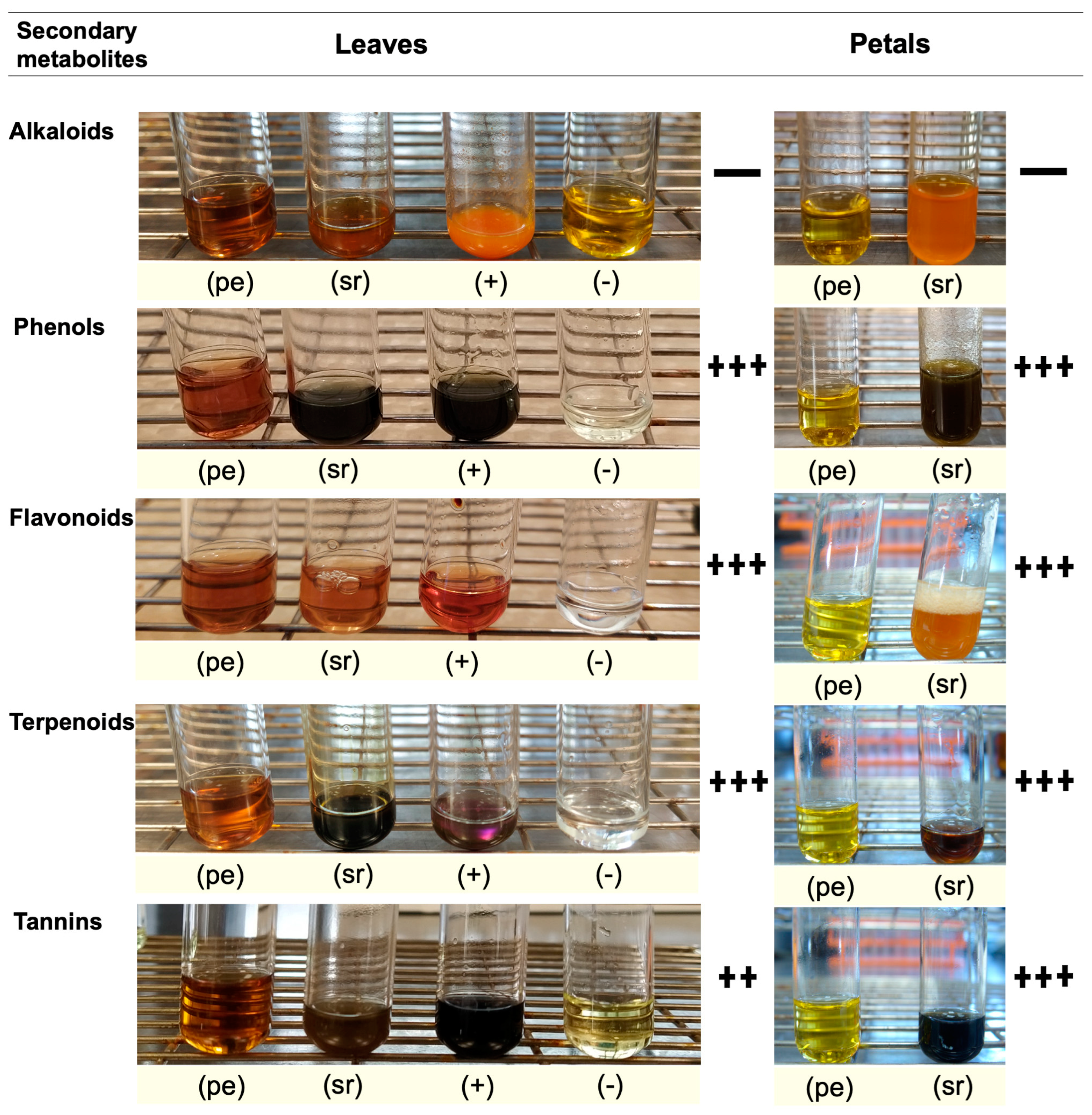
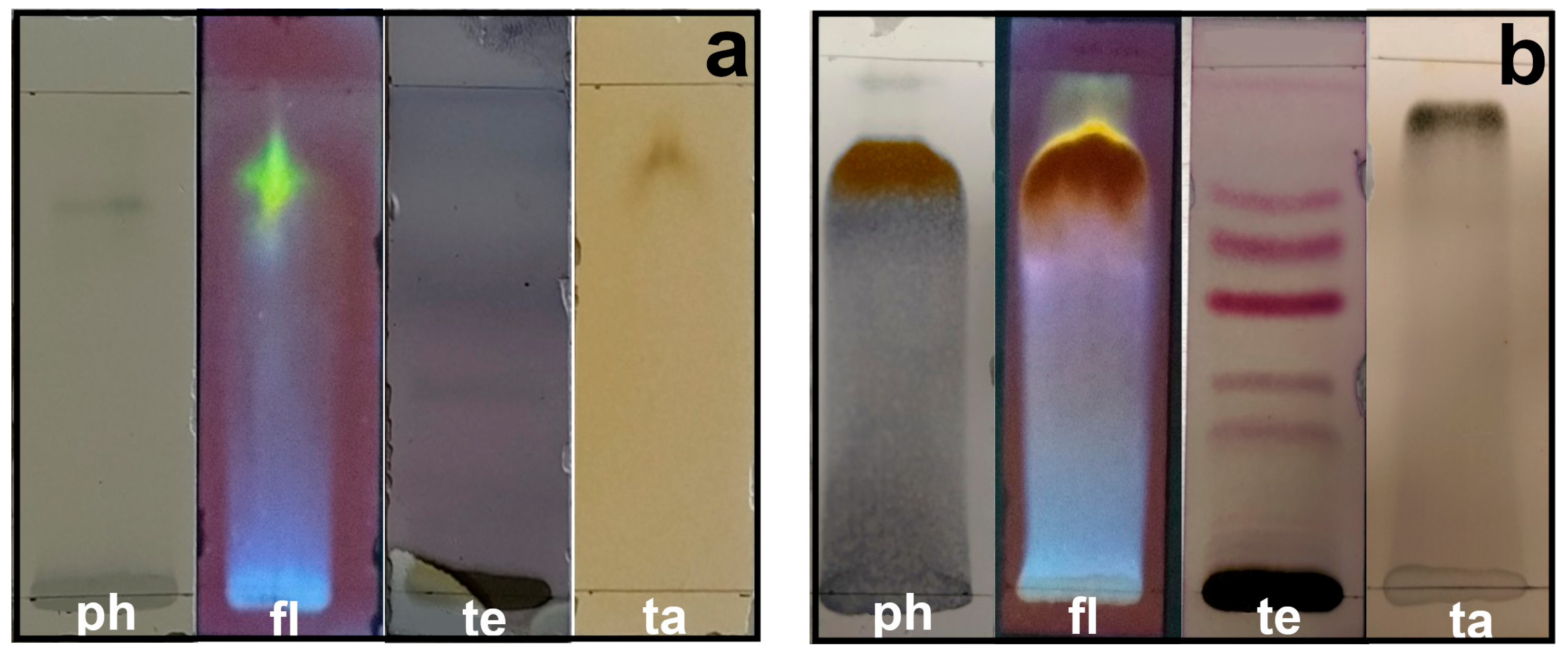
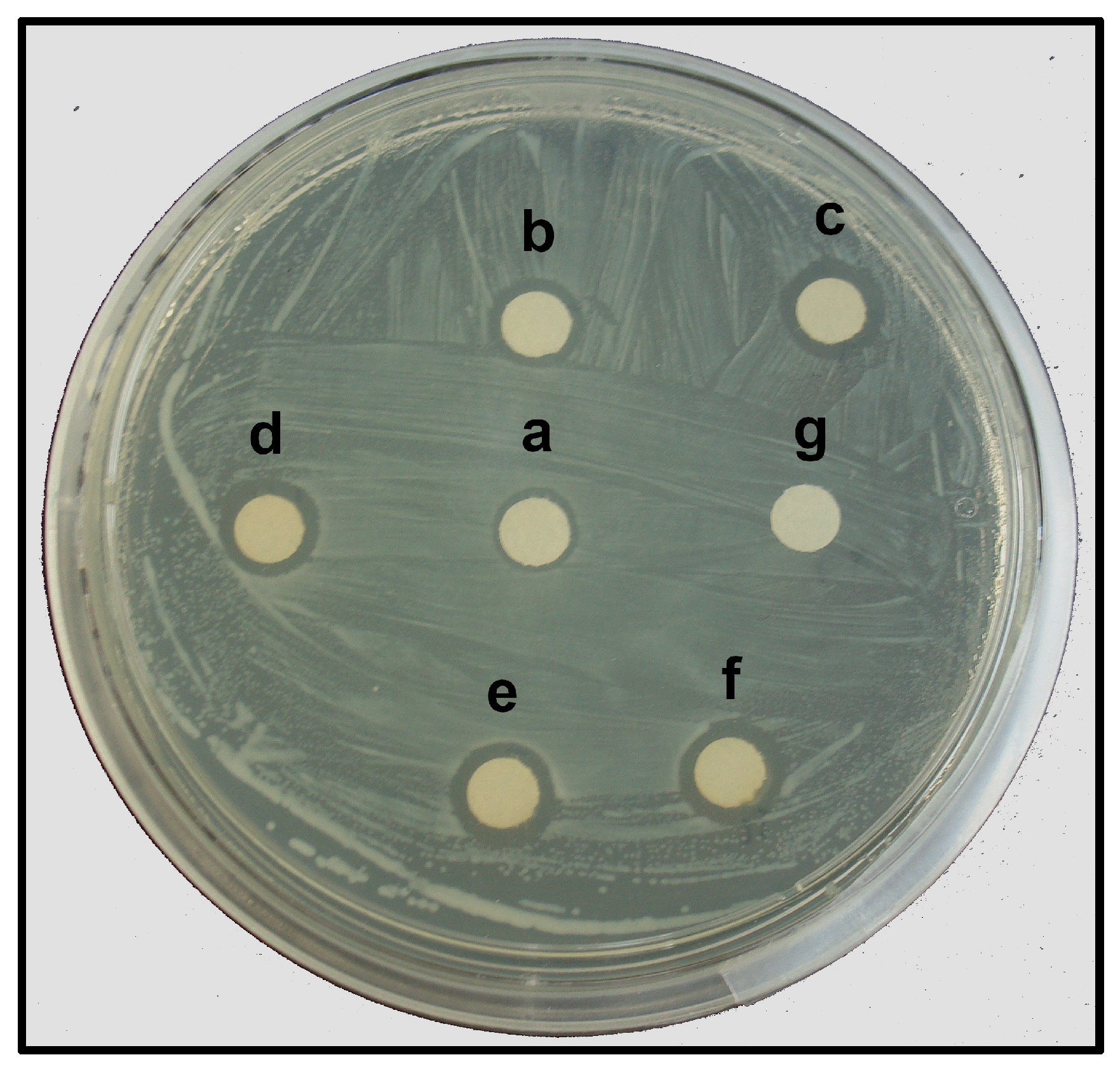
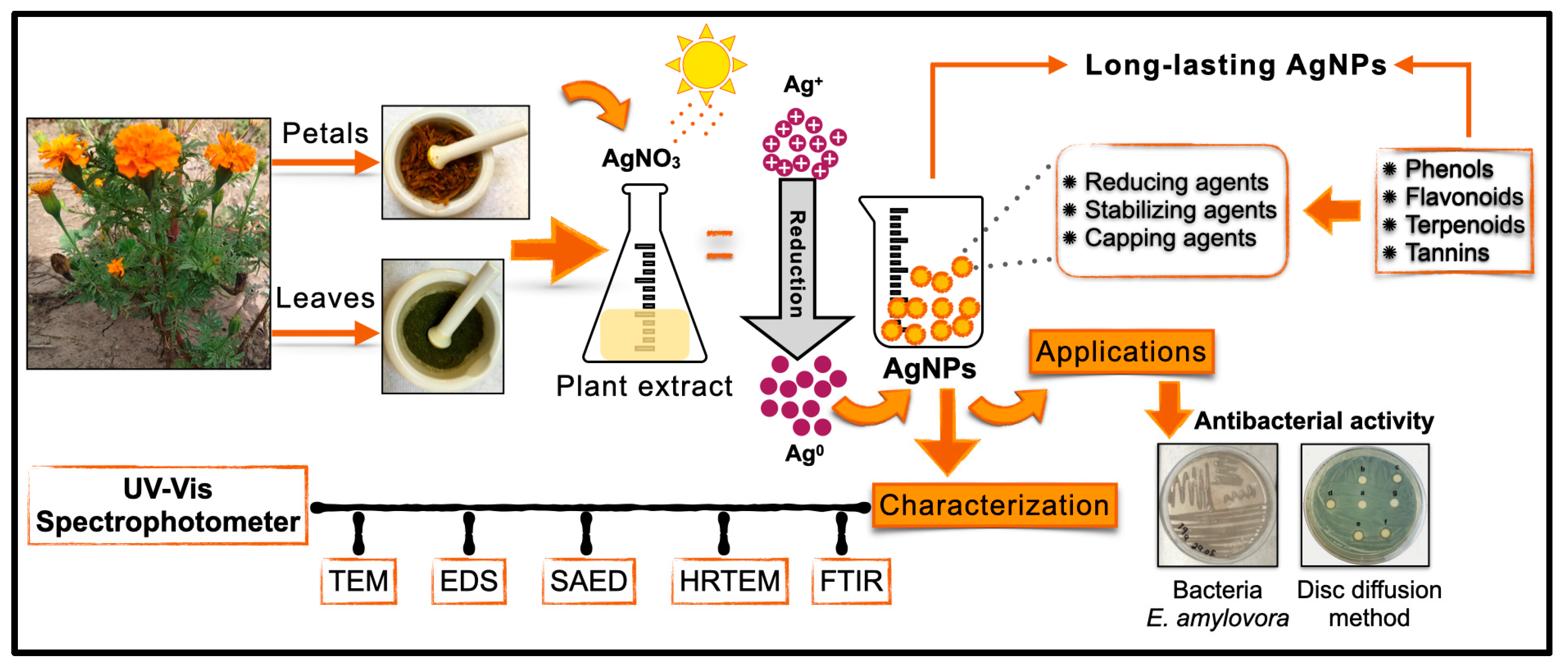
| Extract Volume (mL) | pH | Absorbance * (a.u.) | Wavelength * (nm) | Particle Size (nm) | FWHM (nm) | Particle Sphericity Index | |
|---|---|---|---|---|---|---|---|
| Leaves | 1 | 5.45 | 2.46 | 433 | 17.64 ± 8.87 a | 188 | 0.85 ± 0.09 b |
| 3 | 5.39 | 4.70 | 448 | 13.18 ± 4.00 b | 160 | 0.86 ± 0.07 a | |
| 5 | 5.39 | 6.56 | 456 | 13.44 ± 5.03 b | 175 | 0.85 ± 0.09 b | |
| Petals | 1 | 3.94 | 6.0 | 443 | 23.04 ± 9.88 a | 158 | 0.86 ± 0.09 NS |
| 3 | 3.64 | 11.69 | 441 | 16.45 ± 5.52 c | 148 | 0.86 ± 0.07 NS | |
| 5 | 3.48 | 13.79 | 448 | 18.40 ± 9.41 b | 156 | 0.85 ± 0.08 NS | |
| AgNPs | Particle Size (nm) | Particle Sphericity |
|---|---|---|
| 15 days after the synthesis | 17.64 ± 8.87 a | 0.85 ± 0.09 a |
| 2 years after the synthesis | 48.12 ± 17.01 b | 0.82 ± 0.10 b |
| Concentration of AgNPs (mg L−1) | IZ (mm) |
|---|---|
| 25 | 7.66 ± 0.29 d |
| 50 | 8.56 ± 0.53 c |
| 100 | 9.12 ± 0.40 b |
| 200 | 9.56 ± 0.48 ab |
| 360 | 9.88 ± 0.60 a |
| Positive control (360 mg L−1 of AgNO3) | 9.91 ± 0.41 a |
| Negative control (Deionized H2O) | NA |
Disclaimer/Publisher’s Note: The statements, opinions and data contained in all publications are solely those of the individual author(s) and contributor(s) and not of MDPI and/or the editor(s). MDPI and/or the editor(s) disclaim responsibility for any injury to people or property resulting from any ideas, methods, instructions or products referred to in the content. |
© 2024 by the authors. Licensee MDPI, Basel, Switzerland. This article is an open access article distributed under the terms and conditions of the Creative Commons Attribution (CC BY) license (https://creativecommons.org/licenses/by/4.0/).
Share and Cite
Zarate-Escobedo, J.; Zavaleta-Mancera, H.A.; Soto-Hernández, R.M.; Pérez-Rodríguez, P.; Vilchis-Nestor, A.R.; Silva-Rojas, H.V.; Trejo-Téllez, L.I. Long-Lasting Silver Nanoparticles Synthesized with Tagetes erecta and Their Antibacterial Activity against Erwinia amylovora, a Serious Rosaceous Pathogen. Plants 2024, 13, 981. https://doi.org/10.3390/plants13070981
Zarate-Escobedo J, Zavaleta-Mancera HA, Soto-Hernández RM, Pérez-Rodríguez P, Vilchis-Nestor AR, Silva-Rojas HV, Trejo-Téllez LI. Long-Lasting Silver Nanoparticles Synthesized with Tagetes erecta and Their Antibacterial Activity against Erwinia amylovora, a Serious Rosaceous Pathogen. Plants. 2024; 13(7):981. https://doi.org/10.3390/plants13070981
Chicago/Turabian StyleZarate-Escobedo, Johana, Hilda Araceli Zavaleta-Mancera, Ramón Marcos Soto-Hernández, Paulino Pérez-Rodríguez, Alfredo Rafael Vilchis-Nestor, Hilda Victoria Silva-Rojas, and Libia Iris Trejo-Téllez. 2024. "Long-Lasting Silver Nanoparticles Synthesized with Tagetes erecta and Their Antibacterial Activity against Erwinia amylovora, a Serious Rosaceous Pathogen" Plants 13, no. 7: 981. https://doi.org/10.3390/plants13070981
APA StyleZarate-Escobedo, J., Zavaleta-Mancera, H. A., Soto-Hernández, R. M., Pérez-Rodríguez, P., Vilchis-Nestor, A. R., Silva-Rojas, H. V., & Trejo-Téllez, L. I. (2024). Long-Lasting Silver Nanoparticles Synthesized with Tagetes erecta and Their Antibacterial Activity against Erwinia amylovora, a Serious Rosaceous Pathogen. Plants, 13(7), 981. https://doi.org/10.3390/plants13070981









